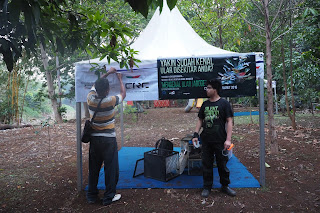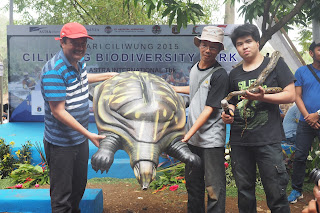Thanks to everyone who has donated, last month we have managed to renovate the bulk of our live animal displays.
As we have increased our animal welfare, we have reduced our collection greatly to only have animals which serve an educational purpose and/or cannot be released. The non-native species are kept off-show in an area we have rented.
Also we have increased our educational value, to highlight several issues in Indonesia. All the infographics are done in an easy-to-understand manner (e.g. cartoons and pictures, minimal text), in order to get more interest for those visiting. Our signage for each animal for example, consists of a photograph of the species, it's common, local and scientific name, and symbols indicating it's diet, habitat and venom toxicity.
In the river section, we talk about the invasive species problem, mainly in the turtle enclosure, where we tell the story of how the red-eared slider from America threatens the survival of our native black marsh turtle, which we have on display. Next to it, we have a wall highlighting the rubbish issue in the river, having a display of various types of rubbish, it's effects on humans and the ecosystem, and what people can do to help. We also have on display an aquarium of native fish and water snakes of the Ciliwung River.
Next we have a Poison & Venom section, where we try to educate people about poison and venom, their differences and the biology of the creatures that possess it. Therefore we have a representation of a poisonous animal (river toad), venomous animal (spitting cobra), and a poisonous and venomous animal (red-necked keelback). We try to include several fun-facts about these animals, for instance the fact that the keelback will feed on toads and sequester the poison, making it highly toxic. However, the main issue lifted here is the snakebite issue in Indonesia. We try to educate people using posters and cartoons on how to prevent snakebite, the correct first aid for snakebite, common practice of incorrect first aid, and the lack of antivenom.
However, we do not want people to dislike snakes due to the existence of snakebite. In our next section, we talk about why reptiles are important to us and the ecosystem, and the common misunderstandings of snakes. Here we have on display two species of common green snakes, which are both often considered to be dangerous. However, the vine snake is harmless whereas the bamboo pit viper is highly venomous. We have a poster containing pictures of the two and showing the differences between them to enable locals to better understand the animals around them.
However, we still need funding to maintain our off-show area, which we have rented in order to keep rescued animals which cannot be released, and as a quarantine and rehabilitation facility for animals which will be on display and/or released in the future.
Next year we plan to add some non-living educational material, such as videos, skeletons, books, etc. Also if all goes well, we plan to have more live animals (a tokay gecko enclosure, and an amphibian one as well) in the empty space that we have. Any donations would be greatly appreciated, no matter how small.
As we have increased our animal welfare, we have reduced our collection greatly to only have animals which serve an educational purpose and/or cannot be released. The non-native species are kept off-show in an area we have rented.
Also we have increased our educational value, to highlight several issues in Indonesia. All the infographics are done in an easy-to-understand manner (e.g. cartoons and pictures, minimal text), in order to get more interest for those visiting. Our signage for each animal for example, consists of a photograph of the species, it's common, local and scientific name, and symbols indicating it's diet, habitat and venom toxicity.
In the river section, we talk about the invasive species problem, mainly in the turtle enclosure, where we tell the story of how the red-eared slider from America threatens the survival of our native black marsh turtle, which we have on display. Next to it, we have a wall highlighting the rubbish issue in the river, having a display of various types of rubbish, it's effects on humans and the ecosystem, and what people can do to help. We also have on display an aquarium of native fish and water snakes of the Ciliwung River.
Next we have a Poison & Venom section, where we try to educate people about poison and venom, their differences and the biology of the creatures that possess it. Therefore we have a representation of a poisonous animal (river toad), venomous animal (spitting cobra), and a poisonous and venomous animal (red-necked keelback). We try to include several fun-facts about these animals, for instance the fact that the keelback will feed on toads and sequester the poison, making it highly toxic. However, the main issue lifted here is the snakebite issue in Indonesia. We try to educate people using posters and cartoons on how to prevent snakebite, the correct first aid for snakebite, common practice of incorrect first aid, and the lack of antivenom.
However, we do not want people to dislike snakes due to the existence of snakebite. In our next section, we talk about why reptiles are important to us and the ecosystem, and the common misunderstandings of snakes. Here we have on display two species of common green snakes, which are both often considered to be dangerous. However, the vine snake is harmless whereas the bamboo pit viper is highly venomous. We have a poster containing pictures of the two and showing the differences between them to enable locals to better understand the animals around them.
However, we still need funding to maintain our off-show area, which we have rented in order to keep rescued animals which cannot be released, and as a quarantine and rehabilitation facility for animals which will be on display and/or released in the future.
Next year we plan to add some non-living educational material, such as videos, skeletons, books, etc. Also if all goes well, we plan to have more live animals (a tokay gecko enclosure, and an amphibian one as well) in the empty space that we have. Any donations would be greatly appreciated, no matter how small.



































